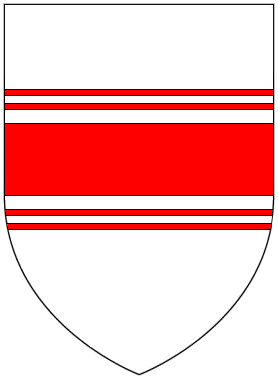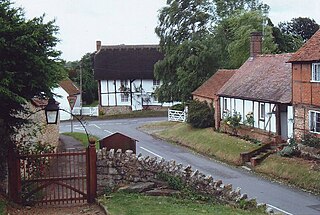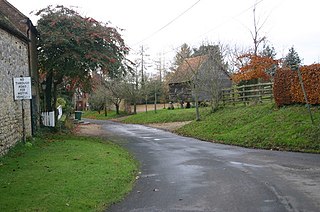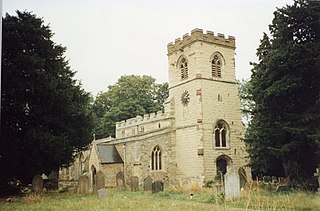
Bartholomew de Badlesmere, 1st Baron Badlesmere was an English soldier, diplomat, member of parliament, landowner and nobleman. He was the son and heir of Sir Gunselm de Badlesmere and Joan FitzBernard. He fought in the English army both in France and Scotland during the later years of the reign of Edward I of England and the earlier part of the reign of Edward II of England. He was executed after participating in an unsuccessful rebellion led by Thomas, 2nd Earl of Lancaster.

Barton Hartshorn is a civil parish about 4 miles (6.4 km) southwest of Buckingham in Buckinghamshire, within the Buckinghamshire Council unitary authority area. Its southern boundary is a brook called the Birne, and this and the parish's western boundary form part of the county boundary with Oxfordshire. At the 2011 Census the population of the parish was included in the civil parish of Chetwode

Beachampton is a village and civil parish beside the River Great Ouse in the unitary authority area of Buckinghamshire, England. The village is about 5 miles (8.0 km) east of Buckingham and a similar distance west of Milton Keynes.

Chilton is a village and civil parish in Aylesbury Vale district in Buckinghamshire, England. It is in the west of the county, about 4 miles (6.4 km) north of Thame in Oxfordshire. Chilton parish includes the hamlet of Easington.

Easington is a hamlet in the civil parish of Chilton, Buckinghamshire, about 3 miles (5 km) north of the Oxfordshire market town of Thame. The hamlet is between the villages of Chilton and Long Crendon and consists of around 30 houses.

Dorton is a village and civil parish in the Aylesbury Vale district of Buckinghamshire. It is in the western part of the county, about 5 miles (8 km) north of the Oxfordshire market town of Thame.
Great Brickhill is a village and civil parish in the unitary authority area of Buckinghamshire, England. It is on the border with the City of Milton Keynes, located 6 miles (9.7 km) south-east of Central Milton Keynes, and 3 miles (4.8 km) in the same direction from Fenny Stratford.

Lillingstone Dayrell is a village in Buckinghamshire, England. It is in Aylesbury Vale, about three and a half miles north of Buckingham, eight miles west of Milton Keynes and five miles south of Towcester. Lillingstone Dayrell with Luffield Abbey and the neighbouring hamlet of Lillingstone Lovell are separate civil parishes within Aylesbury Vale district.

Lillingstone Lovell is a village and civil parish in north Buckinghamshire, England. It is located around 4 miles (6.4 km) north of Buckingham and 8 miles (13 km) west of Milton Keynes, and around 5 miles (8 km) south of Towcester in the neighbouring county of Northamptonshire. Silverstone Circuit is located just over 2 miles (3.2 km) north-west of Lillingstone Lovell.

Ludgershall is a village and civil parish in the unitary authority area of Buckinghamshire, England. It is near the boundary with Oxfordshire, about 5.5 miles (9 km) south-east of Bicester and 5 miles (8 km) west of Waddesdon.

Middle Claydon is a village and civil parish in the Aylesbury Vale district of Buckinghamshire, England. The village is about 5 miles (8 km) south of Buckingham and about 3.5 miles (5.6 km) west of Winslow.

Newton Longville is a village and civil parish in Buckinghamshire, England, within the Buckinghamshire Council unitary authority area. The village is about 2 miles (3 km) south-west of Bletchley in Milton Keynes.
Pitchcott is a village and civil parish in the Aylesbury Vale district of Buckinghamshire, England. It is about 3 miles (5 km) north-east of Waddesdon, slightly less than 4 miles (6.4 km) south of Winslow and slightly more than 4 miles north of Aylesbury. It is in the civil parish of Oving.

Thornton is a village and civil parish on the River Great Ouse about 3.5 miles (5.6 km) north-east of Buckingham in the unitary authority area of Buckinghamshire.

Wotton Underwood is a village and civil parish in Buckinghamshire, England, 7 miles (11 km) north of Thame, Oxfordshire.
Sir Richard Fowler (c.1425-1477) was an English administrator.
Sir William Fowler was an English justice of the peace and Member of Parliament for Wycombe in Buckinghamshire, in 1431. For the services of his father Thomas to King Edward IV, Fowler was given Preston manor in Buckinghamshire in 1465. William's wife was Cecily Englefield, a co-heiress of Nicholas Englefield, Comptroller of the Household for Richard II.
Sir John Gage was a major landowner and grandfather of the Tudor courtier Sir John Gage KG.
Eleanor St Clere was the heiress of a substantial number of manors and grandmother of the Tudor courtier Sir John Gage KG.
Nicholas Gainsford, also written Gaynesford or Gaynesforde, of Carshalton, Surrey, of an armigerous gentry family established at Crowhurst, was a Justice of the Peace, several times Member of Parliament and High Sheriff of Surrey and Sussex, Constable and Keeper of Odiham Castle and Park, Hampshire, who served in the royal households from around 1461 until his death in 1498. Rising to high office during the reign of Henry VI, he was an Usher to the Chamber of Edward IV and, by 1476, to his queen Elizabeth Woodville. Closely within the sphere of Woodville patronage, he was a favourer of Edward V, and was a leader in the Kentish rising of 1483 against Richard III. He was attainted in 1483, but was soon afterwards pardoned, and fully regained his position and estate as Esquire to Henry VII and Elizabeth of York after the Battle of Bosworth Field. He established the Carshalton branch of the Gainsford family.














